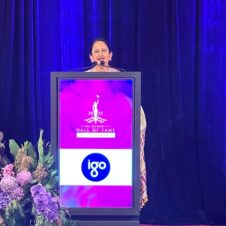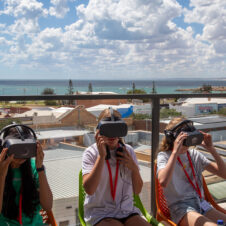
Amelie Parsons counting down “3, 2, 1, mark” and releasing her signal to Proxima Centauri. In less than 20 hours the signal will have overtaken the Voyager probe, launched in 1977!
Dalkeith Primary School students have transmitted a ‘golden record’ into space, filled with illustrations, photos and messages for the Universe.
The Year 5 and 6 students’ transmission was sent this morning from the European Space Agency’s deep space antenna at New Norcia.
The 35-metre antenna is designed to communicate with deep space missions and usually provides routine support to spacecraft such as Mars Express, Rosetta and Gaia.
International Centre for Radio Astronomy Research (ICRAR) senior research fellow Kevin Vinsen, who helped the students devise their messages, said the idea of a ‘golden record’ was inspired by the Voyager space missions.
“In 1977, NASA sent two gold-dipped records into space on board the Voyager spacecraft,” he said.
“They contained 116 images and a variety of sounds meant to represent Earth and humanity—everything from Bach to Louis Armstrong.
“These two records are currently hurtling away from the Solar System, ready to be discovered by any intelligent extra-terrestrial life or future humans who might come across them.”
In devising their own golden record, the Dalkeith students were guided by ICRAR artist-in-residence Loren Kronemeyer.
The students considered the most important messages to send to extra-terrestrial life.
They also thought about the ethical and diplomatic considerations required when speaking to an unknown, unimaginable life form.
Mr Vinsen said the result is a contemporary, youth-led portrait of our species.
“The photos and illustrations depict life from the students’ point of view,” he said.
“They’ve focused on how things have changed on Earth since the Voyager golden records, and what’s important to Generation Z.”
In preparation for their messages to be sent this morning, the students were invited to attend the configuration of the deep space station from the facility’s control room.
They spoke to the European Space Operations Centre in Germany and monitored the transmission of their messages.
Mr Vinsen said the transmission was aimed at Proxima Centauri b, the planet that is our nearest neighbour.
“At the speed of light, our transmission will overtake the Voyager spacecraft in less than a day,” he said.
“When it arrives at Proxima Centauri b, the signal power will be a tiny fraction of a Watt, so our alien friends will need a telescope similar to, or more sensitive than, the Parkes radio telescope to detect it.
“By the time we get a reply, assuming we get one, the students will be at university.
“Hopefully, some of them will be studying STEM because they’ve been inspired by what we’ve done today.”
As a youth-led portrait of our species, Dalkeith Primary School students transmitted a ‘golden record’ into space via the European Space Agency’s New Norcia Deep Space Antenna.
More Information
The International Centre for Radio Astronomy Research (ICRAR) is a joint venture between Curtin University and The University of Western Australia with support and funding from the State Government of Western Australia.
Multimedia
Full resolution images available for download from here.

Current and ex Dalkeith Primary School students with the European Space Agency 35m tracking dish in New Norcia. The dish has just started tracking Proxima Centauri in preparation to send the students’ message to our nearest stellar neighbour.

Student Matthew Maliszewski prepares to start the countdown for ESA operations in Germany to release his signal to Proxima Centauri.

Amelie Parsons counting down “3, 2, 1, mark” and releasing her signal to Proxima Centauri. In less than 20 hours the signal will have overtaken the Voyager probe, launched in 1977!

Hector Mangharam and Angus Marshall watching the transmission of one of the students’ signals to Proxima Centauri.

ESA’s New Norcia station, DSA-1 (Deep Space Antenna-1), hosts a 35 m-diameter parabolic antenna and is located 140 km north of Perth, Western Australia, close to the town of New Norcia. DSA-1 communicates with deep-space missions, typically at ranges in excess of 2 million km. It is also capable of supporting the ultra-precise ‘delta-DOR’ navigation technique. Credit: ESA/S. Marti
Contacts
Kevin Vinsen (ICRAR-UWA)
Ph: +61 8 6488 7743 or +61 435 164 060 E: Kevin.Vinsen@icrar.org
Kirsten Gottschalk (Media Contact, ICRAR)
Ph: +61 438 361 876 E: Kirsten.Gottschalk@icrar.org
Nicola Gebers de Sousa (European Space Agency)
Ph: +49 175 941 54 08 E: Nicola.Gebers@esa.int

